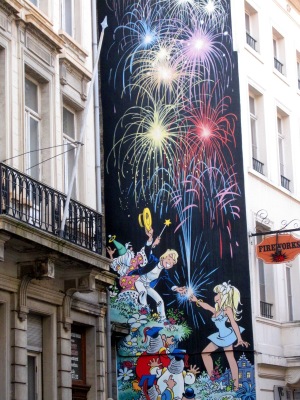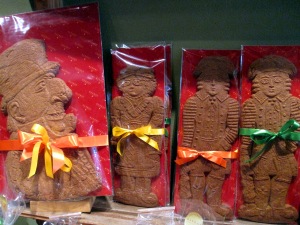You can get a classic moules-frites dinner with mussels, fries and a beer for about €13 in Brussels; Grand Place/Grote Markt is the central square of Brussels and recognized by UNESCO
Several weeks ago, Professor Peter Scholliers of Vrije Universiteit in Brussels stopped by to give our class some lectures on Belgian and European food history of the 19th and 20th centuries. Soon afterwards, one of my roommates noticed that Ryanair flights from Torino to Brussels were quite inexpensive, and there was a four-day weekend coming up, so we made a spontaneous decision to treat ourselves to a weekend in Belgium. After all, isn’t the point of living in Europe that you can fly off at a moment’s notice to another country? I’d like to think we were inspired by class, so this was really a didactic experience anyway.
Some logistical information: Ryanair flights from Torino land in Charleroi, a small airport about 60 km south of Brussels that serves a number of budget airlines. To get from Charleroi airport to Brussels proper, you can either take the Autocars l’Elan shuttle bus to Gare du Midi (€13/22 rt, tickets sold on board), or you can hop on a bus (€2,70) to the Charleroi train station and then take a train from there to Brussels (€8,60). The shuttle is slightly more expensive and takes less time, while the bus + train combo allows you to go to any of Brussels’ three main train stations (Midi, Centraal, Nord). This was also my first time flying Ryanair, and that is an experience in itself. Luckily, I was too tired to notice much of my surroundings, but the flight was essentially a 90-minute long informercial, as the airline attendants hawked food, credit cards, lottery tickets, something or another to save the children…At the end of the flight, they played a trumpet reveille to announce that the plane had landed on time. Thank god, because I was ready to jump out the window.
Manneken-Pis trio: the original version of Brussels’ most famous pissing statue, dressed in a chef’s uniform; a lifesize version wrapped in a Belgian flag eating a waffle; Manneken-Pis pissing into an oversized beer glass
After successfully navigating to Brussels Centraal, Danielle and I stepped outside and beelined to the first fry shack on the corner. Munching thick-cut golden frites piping hot in a paper cone is something that everyone ought to do before they die. Belgian fry shacks are known for their plethora of unusual dipping sauces, so we duly tried the Samurai and Curry Ketchup sauces. Though it sounded interesting, the samurai sauce was actually sort of disappointing, a one-note sweet & sourish concoction. The curry ketchup, on the other hand, actually had some firey kick to it.
Hunger satiated, we began looking around to see men pissing everywhere in the streets. No, Brussels doesn’t have a homeless problem (though we saw our share of bums), I am referring to the city’s most infamous landmark, the Manneken-Pis statue. In Dutch, this means little man pee, and the city has fully embraced their publicly urinating wunderchild in the form of merchandise knock-offs, artwork and other parodies. Maybe I should have bought a Mannekin-Pis corkscrew after all? The statue itself is quite small, located above a fountain where a stream of water squirts to the basin below. On this particular day, Manneken-Pis was dressed in a chef’s toque, uniform and wooden spoon. His outfit changes several times a week, according to a schedule posted on the railings around the fountain. Occasionally, the statue is hooked up to a keg of beer, and glasses of beer are filled from the statue and given to passer-byers.
Brussels’ many sky-lit covered arcades provide hours of pleasant window shopping; comics and murals (this is after all the home of Tintin and the Smurfs) decorate many buildings downtown
The city has a great cosmopolitan vibe, with a good mix of locals, tourists and diverse ethnicities. What a change from small-town Italy! Essentially, you get French-influenced cuisine + German efficiency – French snobbery. Everyone we spoke to was warm and friendly, and we were even offered (unsolicited) directions on a couple occasions. (That hasn’t happened to me since I left the Midwest.) Downtown Brussels offers a good mix of large chains, indie retailers, book stores, kitchen supplies and bars. I must admit though that my most exciting discovery in Brussels was the Kam Yuen Asian supermarket, where you can find all sorts of Chinese, Japanese and southeast Asian ingredients, albeit at import prices. The constraints of luggage space held me back somewhat, but I was ecstatic to tote home (after pleading with airport security) galangal paste, satay powder, pickled mustard greens and glutinous rice flour. I would move to Brussels in a heartbeat.
Clockwise: a smörgåsbord of seafood (with fresh sea urchins) on display on Rue des Bouchers; speculoos spice cookies are a Belgian specialty; barrels on beer trays on display at Delirium Cafe; a selection of lambics inside one of Brussels’ ubiquitous beer shops
Traditional Belgian foods like galangal and mung beans aside, we did spend plenty of time exploring the other specialties on offer. Despite Prof Schollier’s insistence that moules-frites is not a dish of exclusively Belgian origin, there was plenty of evidence that it has been adopted wholeheartedly as part of local food culture. Walking down the narrow, pedestrian-packed alley of Rue des Bouchers, we were greeted and gently accosted by many ribald waiters who tried to entice us into their establishments for moules-frites and a beer. “Hey ladies, did I hear you say that you are looking for Belgian husbands? Come in here to eat, sometimes we do massages after the dinner service!” And after you finish your pot of mussels, it is time to drink another beer. Bars and beer shops line the streets, and unlike the US, there are no open container laws, so you can drink a beer while strolling to the bar to get your next beer…I don’t know why more Belgians don’t do this. To be fair, the bottle that I picked up at the Bier Tempel was a fair trade banana beer, therefore I maintain that I was drinking responsibly.
Perhaps the most famous bar in Brussels is Delirium Cafe, located in an even smaller cul-de-sac off of Rue des Bouchers. With over 2,000 beers available, they hold the world record for the greatest number of beers at a bar. Look for beers from your local brewery here; you might be surprised to find them. The regular menu on the tables is not particularly impressive, but you can obtain a copy of the full catalog with detailed descriptions to take home for €5, a good investment for beer connoisseurs. Although the main floor is eye-stinging smoky and the basement is frat-house loud, we were quite happy upstairs in the Hoppy Loft, which was relatively deserted at 6 pm on a Friday evening. Also, Delirium is actually comprised of several bars, so if you want to branch out from beer, there are bars dedicated to tequila and rum as well. We made our way across the alley to the rum bar, festooned with tri-corner hats, netting and scantily clad booty. Though she was initially doubtful, Danielle was overjoyed to find her favorite rum in the catalog. As we sipped the vanilla-perfumed 15-year aged Haitian Rhum Barbancourt, a Belgian jam band set up and began playing Elvis Presley. Let’s hear it for globalization.
Clockwise: Delirium Tremens and the distinctive pink elephant logo (you can get a pink elephant hat for just €10); chocolate acorns, corncobs and leafs suitable for autumn; Pierre Marcolini’s chocolate work feels just a little too precious
Naturally, when you travel to Belgium with a pastry chef in tow, you end up stopping at a lot of chocolate shops. The guidebooks tend to mention the big three Brussels chocolatiers: Pierre Marcolini, Neuhaus and Wittamer, which all have locations on the Grand Sablon rotary. We duly trooped there to investigate, but to be honest, we left feeling a little bit underwhelmed. Chocolate as a commodity is often far-removed from its tropical origins, and is fetishized and converted into a luxury product whose price has little to do with the joy of eating a chocolate piece or compensating the people who grew the beans. At Pierre Marcolini’s shop, I gazed at a number of carefully assembled chocolate pastries and confections, each done with a serious eye for design and aesthetics. It was beautiful, stunning and stark. I felt no emotional connection to the work, and left quickly without buying anything.
On the other hand, Danielle and I were captivated by the praline-filled acorns and corn cobs at Chocolatier Elisabeth, so while I helped myself to free samples, she went to speak with the sales clerk about how to obtain those molds. Of course, the clerk did not reveal this information, saying only that the molds were “professional,” but she did point us to Planete Chocolat, another chocolate shop just a few blocks away. Planete Chocolat sells the usual array of truffles, pralines and mendiants, but they also expend a good deal of effort on education. There is a separate classroom next door, and through their demonstrations and workshops, you can learn about the origins of cacao, how chocolate is manufactured and its continuing evolution. It was here that I first learned of Dominique Persoone, a chocolatier whose flagship store is in Bruges, and author of Cacao: the Roots of Chocolate | Expedition in Mexico.
The next day, we set off for Bruges.














